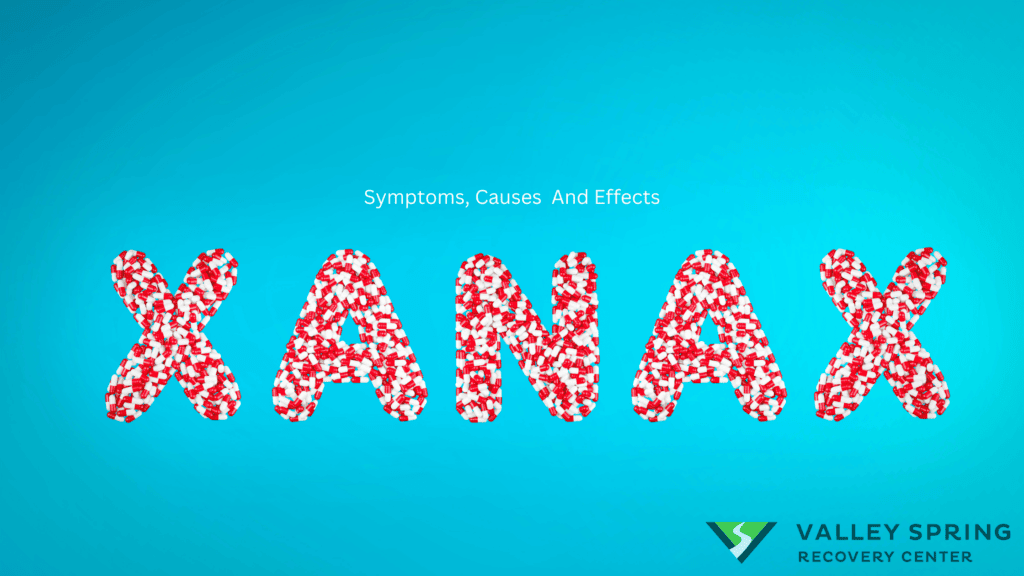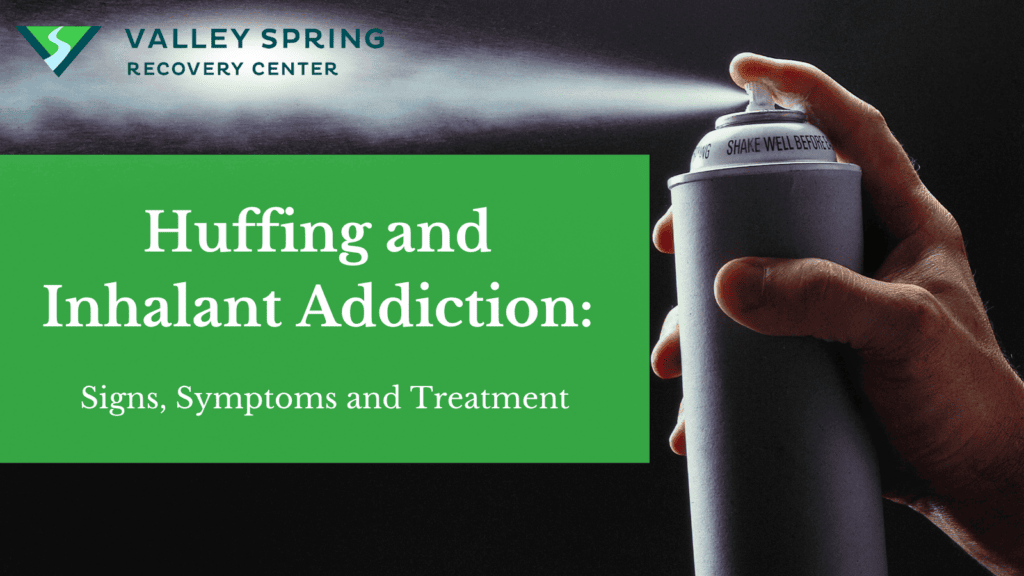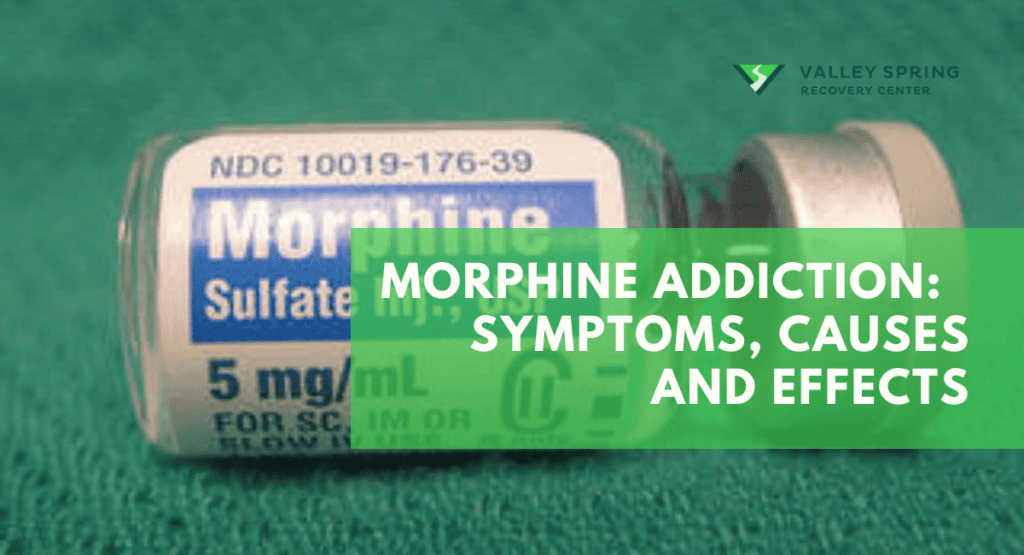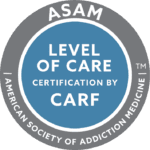Xanax, or alprazolam, is a potent central nervous system depressant within the benzodiazepine family of medications. It works by enhancing the activity of a neurotransmitter called gamma-aminobutyric acid (GABA) in the brain. This increased GABA activity results in a calming and sedative effect, which can alleviate symptoms of anxiety, panic disorders, and sometimes insomnia. Xanax can also be addictive and lead to physical and psychological dependence, impacting health and well-being.
The symptoms of Xanax addiction include increased tolerance, withdrawal symptoms when not using, social isolation, impaired memory and coordination, and neglect of responsibilities, all signaling a dangerous dependency.
The causes of Xanax addiction include legitimate medical use, leading to tolerance, or recreational misuse seeking relaxation or euphoria, with genetics and underlying mental health issues playing contributing roles.
The effects of Xanax addiction include impaired cognitive function, physical health deterioration, strained relationships, financial troubles, and an increased risk of overdose and mental health disorders.
What Is Xanax Addiction?
Xanax addiction is a dependency on alprazolam, a medication prescribed for anxiety and panic disorders. Misuse leads to tolerance, requiring higher doses for the same effect where continued use occurs despite the consequences. Withdrawal symptoms such as insomnia and anxiety occur when the drug is not taken which reinforces the repeating cycle of addiction.
Xanax addicts will continue to use at an increasing dosage even when the consequences are obvious, including withdrawal symptoms, neglecting responsibilities and seizure of death.
Xanax is a benzodiazepine drug that is known for its fast onset of action, making it effective in quickly reducing anxiety and panic symptoms but it also has a high dependency risk. Additionally, when Xanax use is discontinued, a phenomenon called protracted withdrawal may occur where withdrawal symptoms are experienced for up to a year. Symptoms will be milder than acute withdrawal and they can disappear for weeks at a time and then pop back up.
What are the signs and symptoms of Xanax addiction?
Signs and symptoms of Xanax addiction, also known as benzodiazepine use disorder, can vary from person to person but often include:
- Increased Tolerance: Over time, individuals may need higher doses of Xanax to achieve the same effect they once experienced with lower doses.
- Withdrawal Symptoms: When not using Xanax, individuals may experience withdrawal symptoms such as anxiety, restlessness, insomnia, and even seizures, which can drive continued use.
- Compulsive Use: A strong urge or compulsion to use Xanax, even when it’s causing harm to one’s health, relationships, or responsibilities.
- Loss of Control: Inability to control or cut down on Xanax use, often taking it more frequently or in larger amounts than intended.
- Neglect of Responsibilities: A person may start to neglect their work, school, or family obligations due to Xanax use.
- Social Isolation: Isolating oneself from friends and family, often due to the secrecy or shame associated with addiction.
- Physical and Psychological Changes: This can include drowsiness, slurred speech, poor coordination, memory issues, and changes in mood and behavior.
- Continued Use Despite Consequences: Despite experiencing negative consequences like health problems, legal issues, or strained relationships, individuals may continue to use Xanax.
- Loss of Interest: A decline in interest in activities or hobbies that were once important or enjoyable.
- Doctor Shopping: Seeking multiple doctors or sources to obtain Xanax prescriptions, known as doctor shopping.
- Craving: Intense cravings or a strong desire to use Xanax.
What are the causes of Xanax addiction?
Xanax addiction can have various causes, and it often results from a combination of factors:
- Medical Use: Many individuals develop Xanax addiction when they are prescribed the medication for legitimate medical reasons, such as anxiety or panic disorders. Over time, they may build a tolerance to the drug, requiring higher doses to achieve the same effect.
- Recreational Misuse: Some people misuse Xanax recreationally seeking its calming or euphoric effects. This can lead to addiction when use becomes regular and compulsive.
- Genetics: There is evidence to suggest that genetics can play a role in a person’s susceptibility to addiction. If there’s a family history of substance abuse disorders, it may increase the risk.
- Underlying Mental Health Issues: Xanax is often prescribed to treat anxiety and panic disorders. If someone has an untreated or inadequately managed mental health condition, they may be more likely to misuse the drug, leading to addiction.
- Psychological Factors: Stressful life events, trauma, or chronic stress can make individuals more vulnerable to substance abuse, including Xanax.
- Peer Pressure: Being in social circles where Xanax misuse is common can influence an individual to start using the drug recreationally.
- Ease of Access: Xanax is a prescription medication, but it can sometimes be obtained through illicit means or from multiple doctors (doctor shopping), making it more accessible to potential abusers.
- Lack of Awareness: Some people may not fully understand the addictive nature of Xanax, assuming that because it’s a prescribed medication, it’s safe to use without risk of addiction.
- Self-Medication: People might turn to Xanax to self-medicate for physical or emotional pain, not realizing the potential for addiction.
It’s important to recognize these potential causes and risk factors, as early intervention and seeking help for Xanax addiction is crucial to preventing further harm. If you or someone you know is struggling with Xanax addiction, seeking professional treatment and support is highly recommended.
What are the effects of Xanax addiction?
Xanax addiction affects multiple parts of people that become addicted to it. It’s significant that individuals addicted to Xanax usually have greater mental repercussions than other drugs since Xanax is prescribed to treat mental health issues like anxiety or depression. Taking too much Xanax for an extended period of time has a significant effect on brain chemistry and depression. It’s also very difficult to stop using and can have withdrawal issues which last up to 6 months or even a year in some cases. Here are some of the parts of Xanax addicts that are affected:
- Physical Health Deterioration: Prolonged Xanax use can lead to physical health problems, including respiratory issues, digestive problems, and impaired coordination.
- Mental Health Consequences: Xanax addiction can exacerbate or trigger mental health disorders like depression, anxiety, and mood swings.
- Relationship Strain: Addicted individuals often experience strained relationships with family and friends due to changes in behavior, secrecy, and mood swings.
- Financial Problems: Supporting an addiction can be expensive, leading to financial difficulties and even bankruptcy.
- Work and Academic Issues: Neglecting responsibilities at work or school can result in job loss or academic failure.
- Legal Troubles: Misusing or obtaining Xanax illicitly can lead to legal problems, including arrests and criminal charges.
- Risk of Overdose: Xanax can be particularly dangerous when abused, leading to a high risk of overdose, which can be life-threatening.
- Withdrawal Symptoms: Attempting to quit Xanax can lead to severe withdrawal symptoms, including anxiety, seizures, and even hallucinations, making it challenging to stop using without professional help.
- Social Isolation: Addiction often leads to social isolation as individuals prioritize drug use over relationships.
- Neglect of Self-Care: Addicted individuals may neglect their overall well-being, including proper nutrition and hygiene.
- Cravings and Obsession: Constant cravings for Xanax can consume an individual’s thoughts and lead to preoccupation with obtaining and using the drug.
How does Xanax affect the brain?
Xanax, or alprazolam, affects the brain by enhancing the neurotransmitter GABA’s activity, which reduces anxiety, induces sedation, and relaxes muscles.
Its rapid onset makes it effective for anxiety and panic. Prolonged use may lead to tolerance and dependence, resulting in withdrawal symptoms when trying to quit.
Science shows us that drug addiction can affect the brain, its reward system and how neurotransmitters react to stimuli. Xanax can have negative affects on the brain resulting in impaired memory and cognition, potentially causing mood swings or paradoxical reactions. Misuse, especially with other substances, can lead to overdose and severe side effects.
Responsible, medically supervised use is crucial to avoid these risks associated with Xanax.
What are the types of Xanax addiction?
The Types of Xanax addiction are listed below:
- Prescription Xanax Addiction: This occurs when individuals become addicted to Xanax that has been legally prescribed to them. It often starts with legitimate medical use for conditions like anxiety or panic disorders but can lead to misuse, dependence, and addiction when the drug is taken in higher doses or for longer periods than prescribed.
- Recreational Xanax Addiction: Some individuals use Xanax recreationally or experimentally without a prescription, seeking its calming or euphoric effects. Recreational users may obtain the drug through illicit means or from friends who have prescriptions. This type of addiction usually involves higher doses and a greater risk of harmful consequences.
- Xanax Tolerance and Dependence: Xanax tolerance occurs when the body physically adapts to the dosage, requiring higher and more frequent amounts to get the same feeling.
- Xanax Abuse: Xanax abuse is when an individual abuses or misuses Xanax but does not do it frequently enough to develop a tolerance.
While these are the primary categories, the severity of Xanax addiction can vary widely among individuals. Some may use it occasionally, while others may develop a compulsive need for the drug, leading to more severe addiction.
How was Xanax discovered and when did it become popular?
Xanax was discovered by the American pharmaceutical company Upjohn (now a part of Pfizer) in the late 1960s. The development of Xanax was part of a broader effort to create new benzodiazepine medications, which were intended to provide anxiolytic (anxiety-reducing) and sedative effects without the drawbacks of earlier drugs like barbiturates, which had a higher risk of overdose and dependence.
Dr. Leo Sternbach, a chemist at Upjohn, is credited with the discovery of Xanax. He and his team synthesized a large number of new compounds in search of a safer and more effective anxiety medication. In 1969, they synthesized alprazolam, and it was initially patented in 1971.
Xanax was found to have a rapid onset of action, making it suitable for the short-term treatment of anxiety and panic disorders. It soon gained popularity as a prescription medication for these conditions due to its effectiveness and lower risk of overdose compared to older drugs.
In 1981, the U.S. Food and Drug Administration (FDA) approved Xanax for medical use, and it became one of the most widely prescribed benzodiazepines in the United States. Its discovery marked a significant advancement in the treatment of anxiety and panic disorders, although it also brought attention to the potential for dependence and misuse associated with benzodiazepines.
What Are The Slang Terms For Xanax (Alprazolam)?
The slang terms for Xanax are numerous and can vary by region, but some of the more common ones include:
- Bars
- Xannies or Zannies
- Benzos (short for benzodiazepines, the class of drugs to which Xanax belongs)
- Footballs (referring to the shape of some Xanax pills)
- Ladders
- Blue Devils
- School Buses
- White Boys/Girls
- Planks
- Handlebars
- Green Monsters
How do people use Xanax?
Xanax is typically prescribed in tablet form for oral consumption. It’s essential to use Xanax exactly as prescribed by a healthcare professional to minimize health risks and potential for addiction. Here are the common methods of consuming Xanax:
- Oral Tablets: The most common method is taking Xanax tablets orally with water. The tablets are designed to be swallowed whole. They are available in immediate-release and extended-release formulations, with different dosages based on the individual’s needs.
- Sublingual Administration: Some forms of alprazolam, like Xanax XR (extended-release), are not meant to be crushed or split. However, there are sublingual (under the tongue) formulations of alprazolam available. These are designed to dissolve quickly when placed under the tongue and are absorbed through the mucous membranes. Sublingual administration can lead to faster onset of action compared to swallowing a tablet.
- Crushing and Snorting: It’s essential to emphasize that this method is unsafe and not recommended. Some individuals misuse Xanax by crushing the tablets into a fine powder and snorting it through the nose. This can lead to a rapid and intense high but also significantly increases the risk of overdose, addiction, and damage to the nasal passages.
- Injection: Injection of Xanax is another dangerous method of misuse. Crushing and dissolving Xanax tablets for injection can lead to serious health consequences, including infection, vein damage, and overdose.
It’s crucial to use Xanax only as prescribed by a healthcare provider and to follow their instructions carefully. Misuse of Xanax can result in severe health risks, including addiction, overdose, and other adverse effects.
Valley Spring Recovery Is Only A Phonecall Away
What are the Treatment Options for Xanax addiction?
Treatment for Xanax addiction typically involves a combination of medical and behavioral interventions to help individuals safely withdraw from the drug, manage cravings, and address the underlying causes of addiction. Here are some common treatment options for Xanax addiction:
- Medical Detoxification: Medical detoxification, often conducted in a supervised facility, is the first step in treating Xanax addiction. It involves gradually tapering down the dosage of Xanax to minimize withdrawal symptoms. Healthcare professionals may also use other medications to manage severe withdrawal symptoms, such as seizures.
- Behavioral therapy: Behavioral therapy is a fundamental component of addiction treatment. Therapies like Cognitive-Behavioral Therapy (CBT) and Contingency Management are often used to help individuals understand the reasons for their addiction, develop coping skills, and prevent relapse.
- Individual Counseling: One-on-one counseling sessions with a trained therapist or counselor can help individuals address specific issues related to their addiction, set goals for recovery, and work through personal challenges.
- Group Therapy: Group therapy provides a supportive environment where individuals in recovery can share their experiences, receive encouragement, and learn from one another. It can help reduce feelings of isolation and provide a sense of community.
- Family Therapy: Involving family members in therapy can be essential, as addiction often affects the entire family unit. Family therapy can help improve communication, repair relationships, and provide a support system for the person in recovery.
- Support Groups: Self-help and support groups like Narcotics Anonymous (NA) can be valuable for ongoing support and accountability. These groups offer a sense of community and provide a platform for sharing experiences and strategies for staying clean.
- Dual Diagnosis Treatment: If individuals with Xanax addiction have co-occurring mental health disorders like anxiety or depression, it’s essential to address both conditions simultaneously through integrated treatment.
- Medication-Assisted Treatment (MAT): In some cases, healthcare providers may use medications like diazepam or clonazepam to help individuals taper off Xanax gradually while minimizing withdrawal symptoms. Medication Assisted Treatment (MAT) for addiction can be a useful component of treatment when supervised by a healthcare professional.
- Holistic Approaches: Holistic therapies such as yoga, meditation, art therapy, and acupuncture can complement traditional treatment approaches by addressing the physical, emotional, and spiritual aspects of recovery.
- Relapse Prevention: Developing relapse prevention strategies and a comprehensive aftercare plan is crucial for long-term recovery. Aftercare may include ongoing therapy, support group participation, and regular check-ins with healthcare providers.
The most effective treatment plan for Xanax addiction may vary from person to person, and it’s important that treatment is tailored to individual needs.
How long does it take to detox from Xanax?
The duration of Xanax detoxification (detox) can vary significantly from person to person and depends on several factors, including the individual’s level of dependence, the dosage of Xanax used, and their overall health. Generally, Xanax detox can be categorized as follows:
- Short-Term Detox: For individuals who have been using Xanax for a relatively short period at lower doses, detox may last around a week. During this time, healthcare professionals may gradually taper the dose to minimize withdrawal symptoms.
- Longer-Term Detox: Individuals who have been using Xanax for an extended period, especially at higher doses, may require a more extended detox process. Detox in these cases can last several weeks to a few months.
- Severe Dependence: In cases of severe Xanax dependence or addiction, detox may be more protracted, potentially lasting several months or longer. Tapering the dose gradually under medical supervision is crucial to manage withdrawal symptoms safely.
- Medication-Assisted Treatment (MAT): In some instances, healthcare providers may use medications like diazepam or clonazepam to facilitate a slower and more controlled detox process. This can extend the duration of detox, often over several weeks or months, but it can help manage withdrawal symptoms more effectively.
It’s important to note that detox is just the initial phase of Xanax addiction treatment. While it addresses the physical dependence on the drug, it does not address the underlying psychological and behavioral aspects of addiction.
What withdrawal challenges are associated with Xanax addiction?
Xanax withdrawal can be challenging and uncomfortable, and it’s essential to understand the potential symptoms and risks associated with Xanax withdrawal. These challenges include:
- Anxiety and Panic: Withdrawal from Xanax can lead to a resurgence of anxiety and panic symptoms, often more intense than before. This can be distressing for individuals.
- Insomnia: Many people experience difficulty sleeping during Xanax withdrawal, leading to sleep disturbances and fatigue.
- Depression: Feelings of sadness and depression are common during withdrawal. Some individuals may experience mood swings and emotional instability.
- Irritability and Agitation: Xanax withdrawal can lead to irritability, agitation, and a short temper. These mood changes can strain relationships.
- Physical Symptoms: Physical symptoms may include headaches, muscle pain, tremors, and gastrointestinal issues like nausea and diarrhea.
- Cognitive Impairment: Xanax withdrawal can lead to cognitive difficulties, including problems with concentration, memory, and decision-making.
- Hallucinations and Delusions: In severe cases, individuals may experience hallucinations or delusions during Xanax withdrawal. This is more common when withdrawal is rapid or not supervised by a healthcare professional.
- Seizures: Xanax withdrawal can increase the risk of seizures, particularly in individuals with a history of seizures or those withdrawing from high doses. This risk highlights the importance of medical supervision during detox.
- Rebound Symptoms: Rebound anxiety and panic can occur, meaning that the symptoms Xanax was initially prescribed to treat may worsen temporarily during withdrawal.
- Cravings: Cravings for Xanax can be intense during withdrawal, making it challenging to resist returning to drug use.
- Protracted Withdrawal: Some individuals may experience protracted withdrawal symptoms that persist for weeks or months after discontinuing Xanax. These symptoms can include lingering anxiety, insomnia, and mood disturbances.
What Is The Difference Between Xanax and Other Benzodiazepine Drugs?
Xanax (alprazolam) is one of many benzodiazepine drugs, and while they share certain similarities, there are also differences among them. Here are some key distinctions between Xanax and other benzodiazepines:
- Onset of Action: Xanax is known for its rapid onset of action, typically taking effect within 15 to 30 minutes. This makes it suitable for quickly alleviating symptoms of anxiety and panic. In contrast, other benzodiazepines may have slower onset times.
- Duration of Action: Xanax has a relatively short duration of action, often necessitating multiple doses throughout the day. Some other benzodiazepines have longer durations of action, allowing for less frequent dosing.
- Potency: Xanax is considered a high-potency benzodiazepine, meaning it is effective at lower doses compared to some other drugs in the same class. This can be advantageous for minimizing side effects but also carries a higher risk of tolerance and dependence if misused.
- Uses: While all benzodiazepines have anxiolytic (anxiety-reducing) and sedative properties, they may be prescribed for different purposes. Xanax is commonly prescribed for anxiety and panic disorders. Other benzodiazepines may be preferred for conditions like insomnia, muscle spasms, or epilepsy.
- Half-Life: The half-life of a drug refers to how long it takes for half of the drug to be eliminated from the body. Xanax has a relatively short half-life, which contributes to its rapid onset and shorter duration of action. Other benzodiazepines may have longer half-lives.
- Drug Interactions: Different benzodiazepines may interact differently with other medications. It’s crucial to inform your healthcare provider of all medications you are taking to avoid potentially harmful interactions.
- Withdrawal Severity: When benzodiazepine addicts stop using the drug, withdrawal symptoms occur with varying levels of severity. Xanax withdrawal can be intense due to its short half-life, while withdrawal from longer-acting benzodiazepines may have a more gradual onset.
- Tolerance: Individuals may develop tolerance to the effects of benzodiazepines over time. Xanax’s high potency can lead to tolerance developing more quickly than with some other benzodiazepines.
How Does Xanax affect blood pressure?
Xanax, generically known as alprazolam, is a benzodiazepine medication primarily prescribed for the treatment of anxiety disorders and panic attacks. One of its pharmacological actions includes the modulation of neurotransmitters such as gamma-aminobutyric acid (GABA), thereby eliciting an anxiolytic (anti-anxiety) and sedative effect.
In relation to blood pressure, Xanax may exert a hypotensive effect, meaning Xanax can potentially lower blood pressure. This occurs due to its central nervous system depressant properties, which lead to a reduction in sympathetic nervous system activity. The sympathetic nervous system is responsible for the “fight or flight” response, which includes the elevation of blood pressure. By diminishing this response, Xanax may contribute to a decrease in blood pressure.
However, it’s crucial to note that the hypotensive effects of Xanax are generally secondary to its primary therapeutic actions. If you are taking Xanax and are concerned about its impact on your blood pressure, consult a healthcare professional for personalized medical advice.
Final thoughts on Xanax addiction
Xanax addiction is a serious and complex issue that affects individuals physically, psychologically, and socially. The drug’s rapid onset, effectiveness in treating anxiety and panic, and potential for misuse and dependence make it a subject of concern in the medical and addiction treatment fields.
Understanding the causes, effects, and treatment options for Xanax addiction is crucial for individuals, healthcare providers, and society as a whole. With the right support and treatment, individuals struggling with Xanax addiction can embark on a path to recovery, regain control of their lives, and work toward a healthier future.
Sources
Dr. Michael Olla
All author postsShare This Post










